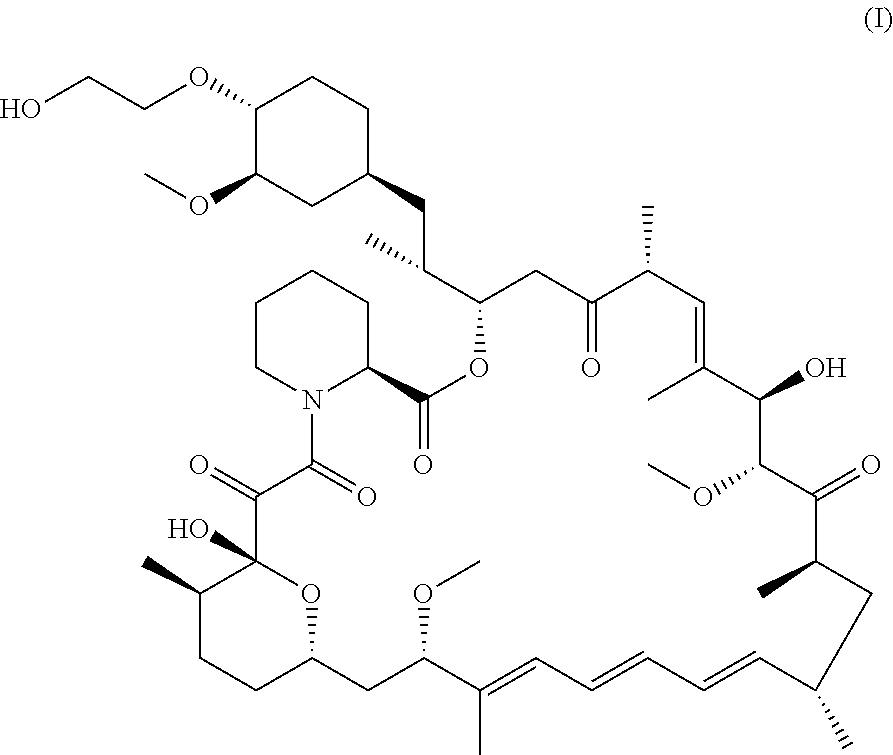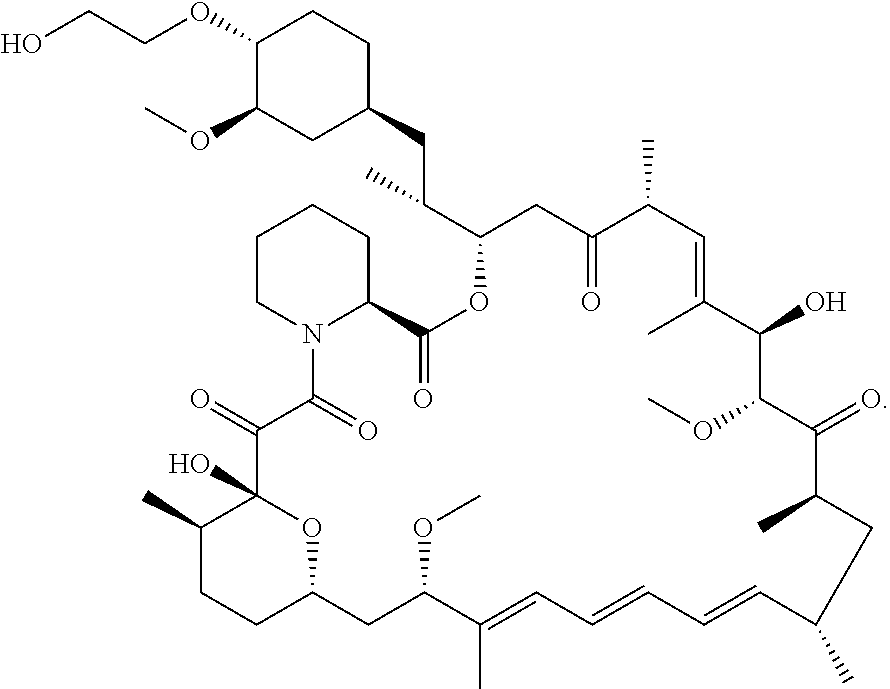Process for the Synthesis of Everolimus and Intermediates Thereof
a technology applied in the field of synthesis of everolimus and intermediates thereof, can solve the problems of impure everolimus formation, poor overall yield and purity, and process is not suitable for commercial scale production
- Summary
- Abstract
- Description
- Claims
- Application Information
AI Technical Summary
Benefits of technology
Problems solved by technology
Method used
Image
Examples
example 1
[0101]Step 1: Preparation of Protected Everolimus (TBS-everolimus) of Formula (Ha) Using Metal Salt, Wherein “Pg” is t-butyldimethylsilyl
[0102]t-butyldimethylsilyloxy ethanol, of formula (VA) (2.8 g, 0.016 mol) was dissolved in dichloromethane (DCM) (3 vol) and to this 2, 6-Lutidine (3.50 g, 0.0327 mol) was added and the mixture was cooled to −40° C. Thereafter, trifluoromethane sulfonic anhydride (3.59 ml, 0.021 mol) was added drop-wise. The mixture was maintained at −40° C. for 30 minutes. Sirolimus (0.5 g, 0.00054 mol) was taken in another flask and dissolved in DCM (1 ml). To this sirolimus solution, silver acetate (0.018 g, 0.000109 mol) was added and cooled to −40° C. The earlier cooled triflate solution was transferred in 3 lots to the sirolimus solution maintaining temperature at −40° C. The reaction mixture was stirred at −40° C. further for 15min before which it was slowly warmed to 0° C. and further to RT. The reaction mixture was then warmed to 40° C. and maintained at t...
example 2
[0104]Step 1: Preparation of TBS-everolimus of Formula (IIa) Without Using Metal Salt, Wherein “Pg” is t-butyldimethylsilyl
[0105]t-butyldimethylsilyloxy ethanol, of formula (VA) (2.8 g, 0.016 mol) was dissolved in DCM (3 vol) and to this 2, 6-Lutidine (3.50 g, 0.0327 mol) was added and the mixture was cooled to −40° C. Thereafter, trifluoromethane sulfonic anhydride (3.59ml, 0.021 mol) was added drop-wise. The mixture was maintained at −40° C. for 30 minutes. Sirolimus (0.5 g, 0.00054 mol) was taken in another flask and dissolved in DCM (1ml). The solution was cooled to −40° C. The earlier cooled triflate solution was transferred in 3 lots to the sirolimus solution maintaining temperature at −40° C. The reaction mixture was stirred at −40° C. further for 15min before which it was slowly warmed to 0° C. and further to RT. The reaction mixture was then warmed to 40° C. and maintained at this temperature for 3 hours. On completion of reaction, the reaction mixture was diluted with DCM ...
example 3
Preparation of Crude Everolimus
Step 1: Preparation of TBS-ethylene Glycol of Formula (Va)
[0107]Ethylene glycol (1.5L, 26.58 mol) and TBDMS-Cl (485 g, 3.21 mol) were mixed together with stirring and cooled to 0° C. Triethyl amine (679 ml, 4.83 mol) was then added at 0° C. in 30-45 minutes. After addition, the reaction was stirred for 12 hours at 25-30° C. for the desired conversion. After completion of reaction, the layers were separated and the organic layer (containing TBS-ethylene glycol) was washed with water (1L×2) and brine solution (1L). The organic layer was then subjected to high vacuum distillation to afford 350 g of pure product.
Step 2: Preparation of TBS-glycol-Triflate of Formula (IVa)
[0108]The reaction was carried out under a nitrogen atmosphere. TBS-ethylene glycol prepared as per step 1 (85.10 g, 0.48 mol) and 2, 6-Lutidine (84.28 ml, 0.72 mol) were stirred in n-heptane (425 ml) to give a clear solution which was then cooled to −15 to −25° C. Trifluoroethanesulfonic a...
PUM
| Property | Measurement | Unit |
|---|---|---|
| temperature | aaaaa | aaaaa |
| temperature | aaaaa | aaaaa |
| temperature | aaaaa | aaaaa |
Abstract
Description
Claims
Application Information
 Login to View More
Login to View More - R&D
- Intellectual Property
- Life Sciences
- Materials
- Tech Scout
- Unparalleled Data Quality
- Higher Quality Content
- 60% Fewer Hallucinations
Browse by: Latest US Patents, China's latest patents, Technical Efficacy Thesaurus, Application Domain, Technology Topic, Popular Technical Reports.
© 2025 PatSnap. All rights reserved.Legal|Privacy policy|Modern Slavery Act Transparency Statement|Sitemap|About US| Contact US: help@patsnap.com



